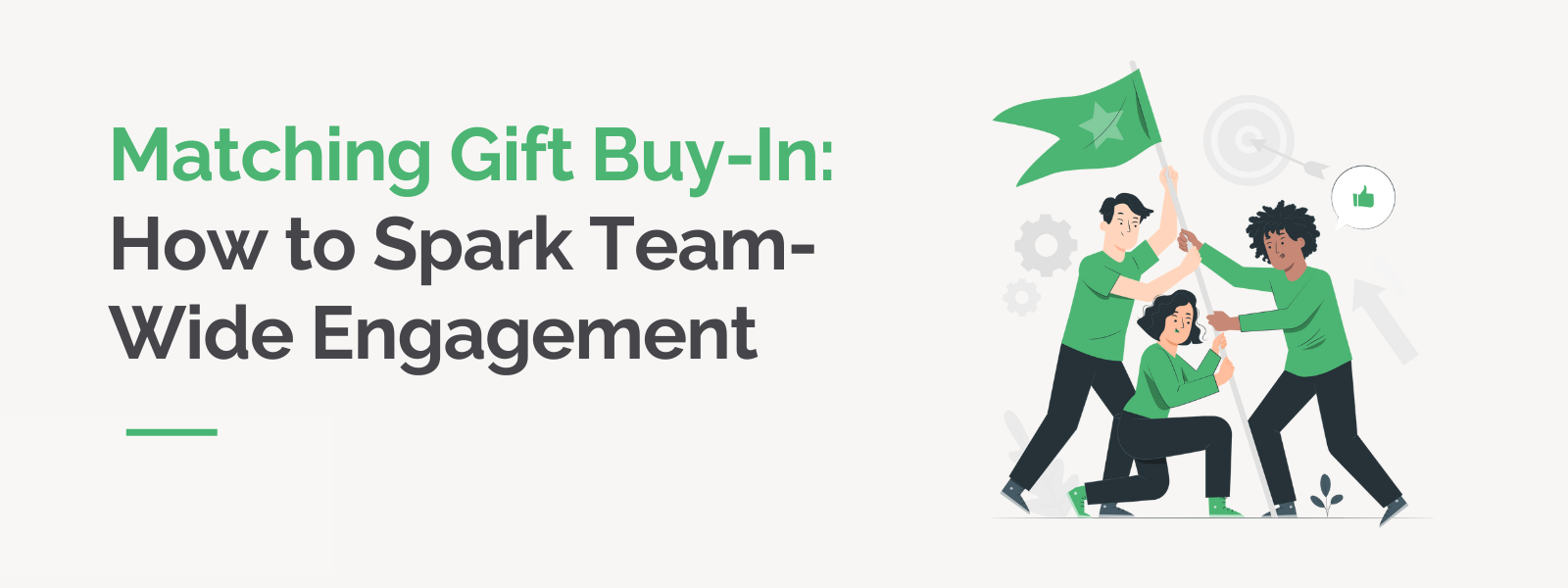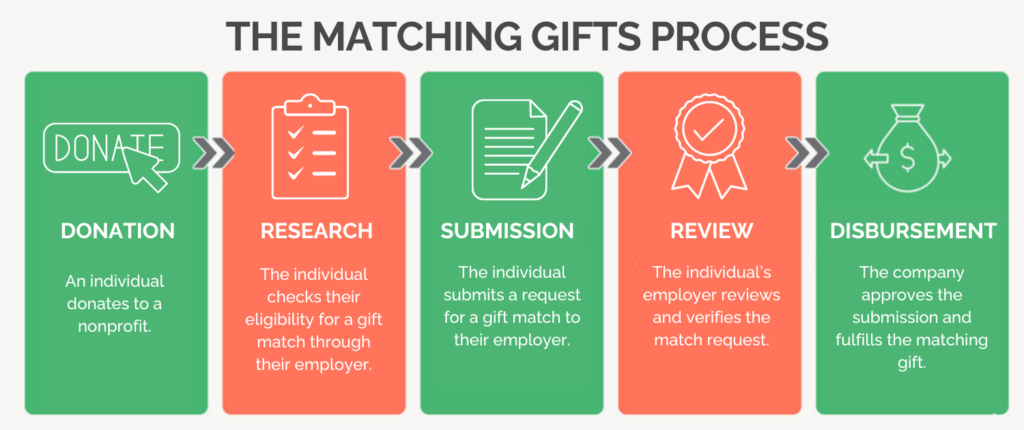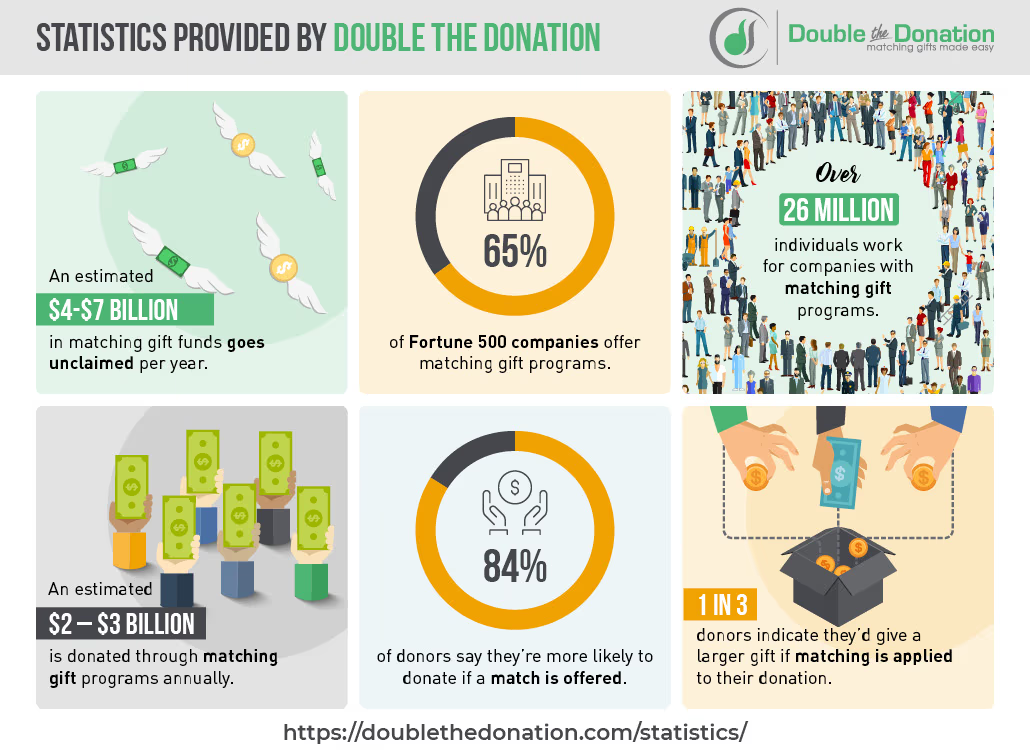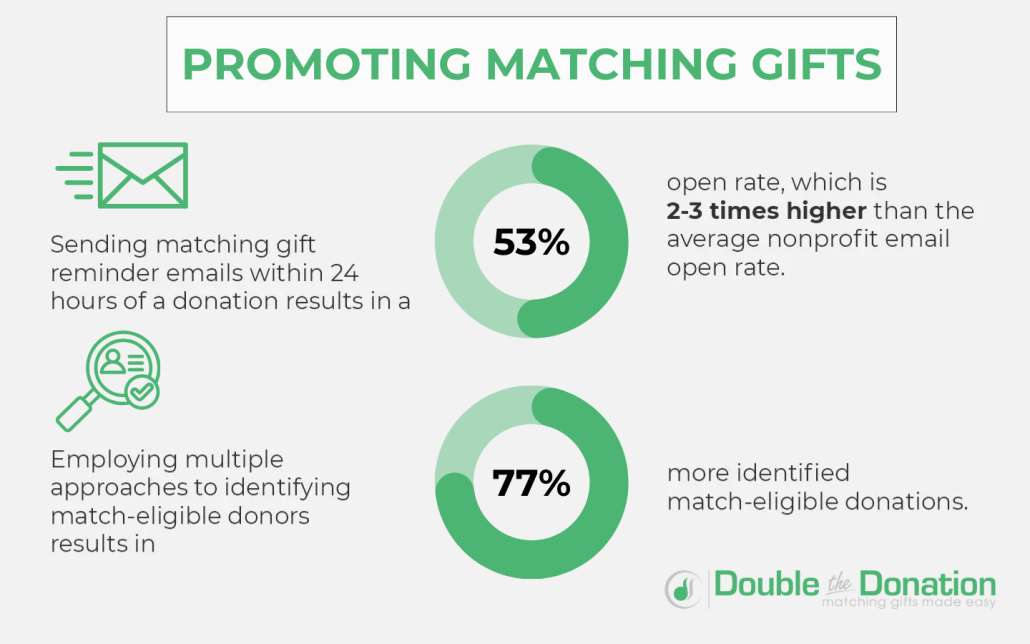Matching Gift Buy-In: How to Spark Team-Wide Engagement
For nonprofit organizations, every dollar counts, and matching gifts are a straightforward, easy way to skyrocket funds. Once they get past the initial lack of knowledge, most nonprofit fundraisers have no issues getting donors motivated and submitting their matching gift requests. The real issue lies with getting your organization’s leadership and staff on board from the get-go to secure matching gift buy-in.
Unfortunately, team members may not initially see the value of matching gifts. They may think their efforts are better spent elsewhere. But as you probably know, matching gifts are a goldmine—and can truly add up with a proactive team (hence why you’re reading this).
If you want to secure every last matching gift dollar possible, you need everyone on board and promoting matching gifts to donors. It’s up to you to clear the gap and build the momentum needed to generate team-wide engagement.
From leadership to staff, rallying up organization-wide support is crucial to fulfilling your matching gift potential. In this article, we’ll cover exactly what you need to accomplish this, from easy ways to educate your team on the process to data you can use to convey the importance of matching gifts. Specifically, we’ll cover:
- Securing Leadership Support
- Securing Staff Support
- Improving the Matching Gift Process
- Data to Share with Your Team
Together, we’ll create an end-to-end plan for securing your portion of the $4 to 7 billion in matching gift funds that go unclaimed each year.
Let’s get started!
Securing Leadership Support
Securing support is easier said than done, but without doing so, any outreach efforts will fall flat. You’ll see a small percentage of matches fulfilled at best. If you fall under this category, take a top-down approach by shifting your focus to leadership.
Sometimes, leadership buy-in can be difficult to acquire. However, you need to get those who are in control to see the value of matching gifts. Attaining support from these powerful individuals gives you the momentum you need to get the entire organization motivated for matching gifts. This is because these individuals can advocate for matching gifts and quickly spread the word to their subordinates.
So this begs the question: how exactly do you secure leadership support?
Considering that many nonprofits are stuck at the mixed buy-in stage and often struggle to get full support, building momentum takes a targeted, proactive approach. Here are great starting points for honing in on high-powered individuals within your organization:
Spend time thinking about matching gifts.
If you’re concerned with the amount of time needed to develop a matching gift strategy, start small. The amount of time necessary for optimizing your strategy is minuscule compared to the amount of matching gifts you could be receiving. All it takes is 3 hours a month.
Each month, return to these core components and add on as you see fit:
- Which donors are eligible but haven’t submitted their matches yet? Reach out and drive these matches to completion.
- What are the top companies where your donors work that don’t have matching gift programs? Initiate a conversation with them.
- Can you identify companies that have had several donors submit matching gifts to your organization? Implement targeted outreach to foster deeper relationships with those employers.
Once you’ve fallen into a routine of consistently evaluating and improving your strategy, urge your leadership to do the same. The more time you spend thinking about matching gifts, the more refined and effective your strategies will be.
Leverage internal data.
Instead of simply talking about the difference matching gifts can make, show them. Humans are visual learners; they prefer to see the potential instead of relying on verbal promises.
In an eye-catching format, display the following organization-specific data:
- Amount of Match-Eligible Donations vs. Actual Submitted Matches
- Total Revenue Raised from Matched Donations
- Number of Donors who Work for Companies that Offer Matching Gifts
Leverage the idea that between 5 and 10% of individual contributions are matching gift eligible, meaning you can substantially stretch donors’ dollars and improve retention. You can also use what other organizations are doing as a benchmark. This can help you make a case for matching gifts from a best-practice standpoint. Ultimately, you should harp on the benefits of matching gifts so you can rally up support sooner rather than later.
Luckily, Double the Donation offers an intuitive format for displaying key data points in a visually engaging way. Below, you’ll see an example of what a customer would see when logging into the Double the Donation platform. Notice how it presents the data in an easy-to-understand and concise way with visuals that demonstrate matching gift growth over time.
This is just a fraction of the data you should be sharing with your leadership. Jump ahead to see additional types of key data points that can help you illustrate your matching gift potential.
Have quick meetings with leadership.
Sometimes, less is more—and you don’t want to take up too much of your leadership’s time. Fortunately, 15-minute-long meetings are all you need to get the matching gift message across. And when you respect leadership’s time, they’ll be much more likely to agree to a meeting in the first place. That’s true even if they’re uncertain or misinformed about your organization’s matching gift potential.
However, you have to make sure you effectively convey your message and generate a sense of urgency in that limited time period. After all, they’re taking time out of their busy days to meet with you, so make it count.
When planning for these meetings, take an education-based approach. Chances are, your leadership has minimal (if any) knowledge of matching gifts. Develop a presentation that spells out the basics and then looks at the long-term influence and expectations for your own organization. You’ll want to prepare actionable talking points to facilitate effective conversations.
After completing your initial one-on-one meetings, join quarterly meetings to keep the conversation going. You can provide updates on impact and matching gift growth within your nonprofit. Then, lead into ways your leadership (and the organization as a whole) can improve its efforts. This could be anything from developing your marketing strategy to improving data collection.
Securing Staff Support
Once you have leadership on board, you can transition your efforts to target the entire staff. Fostering a culture and mindset of matching gifts throughout your organization requires time and effort, but the results are undoubtedly worth it.
Keep in mind that at this stage, leadership will need to take a proactive approach when spreading the word to team members. Otherwise, you won’t build enough momentum to fulfill your potential.
Start by determining which specific staff roles to target in order to build momentum around matching gifts. Then, you can build your efforts out from there. Depending on your approach, tailor your efforts to target…
- Individuals Heading Campaigns and Events. Present the potential matching gift revenue you’re facing with specific fundraisers. This way, they’ll be sure to advertise matching gifts across their communications with attendees.
- The Finance Team. To maintain accurate data, your finance team will need to track and report on matching gifts. From the total matching gift revenue to match-eligible companies within your system, you can pinpoint areas where you’re falling short with your finance team’s assistance.
- The Marketing Team. Marketing matching gifts across all communications maximizes visibility. Your marketing team is consistently conducting outreach, so ensure that those individuals are aware of the benefits that come with matching gifts. From direct mail to emails to social media, they’ll be much more likely to incorporate effective appeals in their outreach to donors when they understand the potential benefits.
As with any strategy, tailor your approach to your own organization’s structure and needs. For instance, higher education institutions will need their advancement team on board, while some nonprofits may need support from their IT departments.
By getting these individuals motivated for corporate giving, you’ll at least begin to generate some buzz around matching gifts. Let’s take a look at specific strategies for doing so:
Educate them via informational resources.
Creating educational guides on matching gifts can generate long-term value for your organization. Better yet, save some time by using these resources developed by the experts at Double the Donation.
You can disperse these throughout your organization to quickly spread the word. When you put the information right in front of your staff, they’ll be more likely to engage than if you urged them to conduct research on their own. Plus, when they’re well-versed in the ins and outs of matching gifts, they’ll be able to answer any questions donors may have.
Remember, educating staff is only half the battle. The other half is ensuring they implement the best practices. By developing specific matching gift training, you can accomplish both of these crucial tasks as quickly as possible.
Incorporate matching gifts into onboarding.
As you refine your strategies, begin training new employees on the matching gift process. This way, they’ll be educated from the get-go.
Depending on your own organization, here are just a few options for getting staff members up-to-speed on matching gifts:
One-Pagers. Explain the process of matching gifts and display some key data to drive your points home. This gives new employees (as well as current ones) a document to reference throughout their time at your organization.
Calls or Meetings. Speaking one-on-one allows staff members to ask any questions they may have. For the best results, make sure you (or whoever conducts the training) are well-versed in matching gifts prior to the call or meeting.
Webinars. Some individuals learn better with a hybrid approach. That is, they prefer presentations that are accompanied by visuals. A webinar is a great way to reach these team members and ensure they’re confident in their matching gift knowledge.
Improving the Process
As you’ve learned, developing an effective strategy is not a one-and-done deal. Rather, it’s an ongoing process. As time passes, you’ll need to refine your efforts in order to acquire optimal results and maintain support. To aid you in the process, consider the following key ideas:
Create a matching gift team.
One of the best ways to generate support is to give individuals personal responsibility in growing your strategies. Instead of relying on every individual to develop their own approach, assign specific individuals to a matching gift team. The more individuals you get involved, the greater the opportunities. You’ll gain a range of perspectives and can optimize your approach to the fullest extent.
However, don’t overload the team with too many members. Rather, take representatives from across the entire organization and consolidate them into one group. Then, task them with the following responsibilities:
- Develop a matching gift plan.
- Determine a budget for matching gift outreach.
- Evaluate marketing opportunities.
- Determine information to provide to donors.
- Consider necessary software investments.
- Evaluate reported metrics.
These are just a handful of the responsibilities you should assign to your matching gift team, but they can serve as a great starting point. As your experience grows, allow the team to adapt its approach. Encouraging select team members to become experts in matching gifts helps you extend your reach in as little time as possible.
Standardize the process organization-wide.
Your organization’s structure plays a crucial role when creating buy-in. The larger your organization, the more difficult it becomes to get and keep everyone engaged—especially when you’re dealing with multiple chapters.
To start, decide on the process you wish to use to promote, track, and reconcile matching gifts. Then, reach out to staff to implement the plan across the board to ensure there are no gaps in your strategies.
Invest in matching gift software to automate the experience.
One of the best ways to improve the matching gift process is to automate the entire thing from start to finish—making it quick and easy for your staff and your donors to get involved. And that involves investing in matching gift software to do so.
For donors, the software simplifies the matching gift process by identifying their eligibility, providing clear instructions, and automating follow-ups, reducing barriers to participation and driving additional revenue through the programs.
For staff, it eliminates much of the manual work involved in tracking, promoting, and managing matching gifts, freeing up time to focus on other critical fundraising activities. By making the process easier and more efficient for everyone, matching gift software helps create a culture of enthusiasm and collaboration, encouraging team members to actively support and promote the program.
Data to Share With Your Team
Nothing speaks louder than numbers. Presenting the benefits of matching gifts may not be enough to get staff and leadership on board unless you have data to back up your claims. Let’s take a look at some of the data you can share with your team in order to get them on board with matching gifts.
General Matching Gift Data
As you get started developing your strategy, you may not be tracking organization-specific data. While specific KPIs will make the largest impact, you can illustrate the bigger picture with general data.
Put the following statistics in front of team members to shed light on the untapped potential that matching gifts present:
- An estimated $4 to $7 billion in matching gift funds goes unclaimed each year.
- 65% of Fortune 500 companies offer matching gift programs.
- Over 26 million individuals work for companies with matching gift programs.
- An estimated $2 to $3 billion is donated through matching gift programs annually.
- 84% of donors say they’re more likely to donate if a match is offered.
- 1 in 3 donors indicate they’d give a larger gift if matching is applied to their donation.
- Sending matching gift reminder emails within 24 hours of a donation results in a 53% open rate, which is 2-3 times higher than the average nonprofit email open rate.
- Employing multiple approaches to identifying match-eligible donors results in 77% more identified match-eligible donations.
Internal Data Nonprofits Should Consider
Sure, the above statistics are great for conveying the bigger picture of matching gifts, but what about your own organization? What do you stand to gain? How can you pinpoint exact numbers when you’re unsure of where to start?
When refining your strategies, there is a variety of data you should track. Track these key metrics and put them in front of your team to create buy-in:
- The number of matching donations
- Total revenue raised from matched donations
- The number of match-eligible donors from this year who did not submit
- The value of the matching gifts for this year’s donors who did not submit
- The number of match-eligible donors from last year who did not submit
- The value of the matching gifts for last year’s donors who did not submit
- Percentage of donations that included matched donations
- Percentage of total revenue raised from matched donations
No matter where you are in building your processes, data can help you build a case for increasing your organization’s focus on matching gifts. With overviews of your data, your organization will quickly be able to see where you’re succeeding and where you have room for improvement.
Pro Tip: Tracking data can be difficult, but you need to know where you currently stand in order to optimize your strategies. Use software like Double the Donation to automate the process.
Concluding Thoughts & Additional Resources
We hope that you’ve found this information to be insightful and helpful in creating buy-in for matching gifts. Corporate giving—matching gifts especially—represents a major revenue opportunity for organizations. The point that defines success is whether or not you ignite organization-wide motivation.
Sparking team-wide engagement is no easy feat, though. Many nonprofit professionals don’t quite see its full value. Because of this, advocating for a cultural shift in mindset to matching gifts requires a hands-on plan of attack.
By expressing enthusiasm and leveraging the tips presented in this guide, you’ll start to gain traction and boost awareness across your organization. With a bit of persistence, you’ll generate the support you need to maximize your revenue potential in no time!
Ready to learn more about making the most of matching gifts? Check out these additional resources to help secure matching gift buy-in:
- Top 20+ Matching Gift Companies: Leaders in Corporate Giving. Communicate the prominence of matching gifts by taking a look at leading employers that already match staff donations.
- Marketing Matching Gifts To Your Internal Team. Marketing matching gifts well is essential, and it should start with your own internal team. Find out how you can do so with this complete guide.
- Corporate Giving and Matching Gift Statistics. Speaking of using data to garner matching gift buy-in, our complete collection of matching gift statistics can help! Demonstrate matching gift value with these helpful insights.







